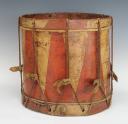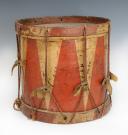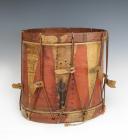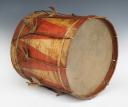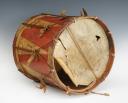
GERMAN INFANTRY DRUM, First half of the 18th century. 28866
GERMAN INFANTRY DRUM, First half of the 18th century. 28866.
Infantry drum, with tension hoops of 4.7 cm in height and 43.3 cm in diameter. The drum consists of the shell, two large hoops, two small rolling hoops, the drumhead (top skin), the snare (bottom skin), ropes, and tensioning rods.
Wooden shell, H 31.5 cm and 41.5 cm in diameter, veneered with straight scarlet flames on a white background. Large shell hoops made of ash wood and pierced with nine holes at equal distances, alternately lacquered white and scarlet. Iron screw hook sliding into a metal tab fixed vertically opposite the tenon; a butterfly nut allows for adjusting the tension of the snare.
Drumheads made of parchment veal and proportioned to the size of the shell. The snare head is thinner than the drumhead.
Ropes used to tighten the skin are made of hemp, cable-laid in strands: they are laced in a zigzag pattern on the shell, passing through the holes in the hoops. Rope circumference is 4 mm.
Tensioning rods made of natural buffalo leather laces, 2 cm to 2.5 cm wide, used as sliders to tighten the ropes.
Germany.
First half of the 18th century.
Good condition, drumhead pierced, wear and rubbing on the wood paint.
NOTE:
There are very few period documents on drummers' uniforms and drums themselves; there are no studies on drum decorations, making it difficult to attribute them to a specific country.
This straight flame design can be observed on a drum preserved in a German municipal museum, with blue straight flames, on an infantry or town drum from the Holy Roman Empire, 18th century.
The Army Museum in Paris, at the Hôtel des Invalides, owns six complete drums and four bare shells from the former monarchy. The six drums have painted wooden shells. Three of the bare shells are copper, and the fourth one is also painted wood. A study was conducted in the 1960s/1970s by the museum curators in the Friends of the Army Museum magazine. This article provides valuable information.
During the reign of Louis XIV and for most of Louis XV's reign, the drum had an oak or chestnut wooden shell, theoretically replaced by a copper shell from 1767 onwards. Its height should be equal to the diameter and measure from 15 to 20 inches, around 405 to 540 millimeters. This rule is not adhered to by any of the drums or drum shells owned by the Museum.
The drumheads, tensioned on a reed, were held at both ends of the shell by wooden hoops about 40 millimeters high, painted blue, with holes for the tension ropes. The top skin is called the drumhead, and the other is the snare. The snare skin is diametrically stretched with the snare rope, an oiled gut cord folded in half, the loop fixed by a pin or hook at the base of the shell, closest to the reed bead, with the two free ends tied to a screw hook sliding into a metal tab fixed vertically opposite the pin; a butterfly nut allows for adjusting the snare tension.
Several drums in the Museum still have original skins, as evidenced by the inscription visible on one of them, which we will discuss later. The tension ropes are mostly from the period. Some of the period ropes have been identified as a "three-strand cord" made before the early 19th century, twisted hemp fibers by hand.
The tensioning rods are of various models; most drums have brown checkered leather rods closing seamlessly, by tenon and mortise; others are simple straps with a tarred thread binding. Only a drum from the Swiss regiment of Castella is equipped with very fine buffalo rods that loop by twisting, in the Prussian style.
The main feature of the drum is obviously the shell. Only wooden shells were made with great care.
Here are the Museum's drums:
- Drum of a bomber company, reign of Louis XIV.
Shell diameter: approximately 435 mm (1); height: 342 mm. Very carefully painted and in good condition. On a gray-green background scattered with large fleur-de-lis arranged in a herringbone pattern stands out a single decorative motif, which logically should be on the visible part when the drum is suspended from its collar in front of the man's body. It depicts a bomber performing the ignition of fire, dressed entirely in red except for the trim of the coat, which is black or dark blue. A curious detail, this soldier is without a hat, and his hair is styled in the fashion of the late 17th century, allowing for dating the drum. The cannon carriage is painted yellow, with black fittings.
The bomber companies, created by Louis XIV, were incorporated into the Royal Artillery in 1720.
- Drum of a company of workers or militia of Brittany, early 18th century. Shell diameter approximately 443 mm; height: 332 mm. Painting in very good condition, but decorations in a very naive style. The background is a beautiful light red. The cylinder surface is vertically divided into three roughly equal parts. On two of them, two large identical and polychrome decorative motifs are painted; two blue oval shields, one with a radiant sun, the other with the three fleurs-de-lis of France, topped with a heraldic helmet with three yellow plumes on a white, framing halberds, pikes, halberds, tails, and flags; there are four flags on each side, one yellow, two blue, and, in the foreground, a white one scattered with the black ermine of Brittany. At the base, two red drums, two cannons back to back, a powder barrel, and a gabion. On one of the fleur-de-lis shields, the lilies have been removed. On the inner wall of the shell is affixed a very nice printed label, the manufacturer's mark: "Louis LEPAGE, master-joiner, makes and sells military shells, fifes, and other instruments. He sells fine and common violins, all at a fair price. He resides in Le Havre, on Rue Saint-Michel, near the Bourse".
As the ermine flags have a place of honor, this drum must undoubtedly be attributed to a Breton unit. But which one? Certainly not to the Regiment of Brittany Infantry, whose flags were quartered with a large Greek cross, which is not the case. Therefore, it is either a company of workers or a militia. The very naive design of the ornamentation leads me to believe that this drum dates from the late 17th century or the very early 18th century. The decoration of the clearly Louis XV-era shells is much more artistic.
- Drum of a Brabant militia, 1725.
Diameter: 455 mm; height: 344 mm. The shell is beautifully decorated, the design of the ornaments is very elegant and meticulous. Three-quarters of its surface are covered with alternating white and dark blue wavy flames, with the dark blue ones pointing upward. On the front face, a 430-millimeter space is painted dark green over the entire height of the shell. It is adorned with a very beautiful decorative motif: under the ducal crown, a large split shield, in the first gold with a lion rising in gules, in the second silver with three wavy azure fesses; it stands out on a bundle of golden flags, guides, standards, and red, blue, and white flags. At the base, two cavalry kettledrums with red and green aprons and two drums with white and blue wavy flames, showing, on each side, the two ends of a white banner inscribed in black letters with the motto: "LUCTOR ET EMERGO ". The joint is reinforced with small round-headed copper nails artistically arranged in geometric patterns. The shell has a small snare tensioner strap, but the adjustment screw is missing.
On the inner wall are attached two interesting labels. One, on bad grayish paper, bears a unfortunately indecipherable handwritten inscription, as the ink is very faded; only the date 1725 is clearly visible. The other, on fine pink paper, in print characters: "LOMBAR TAMBOUR 1742". On the drumhead, in well-crafted English writing, "Lombar 1742" with a sophisticated flourish that would have made an old sergeant-major jealous.
This drum comes from the old arsenal of Douai. The collection file attributes it to a Brabant militia of Elector Maximilian Emmanuel, without further explanation. The name of the brave drummer who marked his shell in the year of our Lord 1742 in two places, is indeed French.
- Drum shell of the Infantry Regiment of Hainaut 1747.
Diameter: 448 mm; height: 340 mm. Painted in gray-green, it is adorned with six large yellow fleur-de-lis arranged in a herringbone pattern on its rear half. On the front face is a very beautiful decorative motif painted with great care: on a large yellow cartouche with the royal crown above, stands out the arms of France with the ord...
Infantry drum, with tension hoops of 4.7 cm in height and 43.3 cm in diameter. The drum consists of the shell, two large hoops, two small rolling hoops, the drumhead (top skin), the snare (bottom skin), ropes, and tensioning rods.
Wooden shell, H 31.5 cm and 41.5 cm in diameter, veneered with straight scarlet flames on a white background. Large shell hoops made of ash wood and pierced with nine holes at equal distances, alternately lacquered white and scarlet. Iron screw hook sliding into a metal tab fixed vertically opposite the tenon; a butterfly nut allows for adjusting the tension of the snare.
Drumheads made of parchment veal and proportioned to the size of the shell. The snare head is thinner than the drumhead.
Ropes used to tighten the skin are made of hemp, cable-laid in strands: they are laced in a zigzag pattern on the shell, passing through the holes in the hoops. Rope circumference is 4 mm.
Tensioning rods made of natural buffalo leather laces, 2 cm to 2.5 cm wide, used as sliders to tighten the ropes.
Germany.
First half of the 18th century.
Good condition, drumhead pierced, wear and rubbing on the wood paint.
NOTE:
There are very few period documents on drummers' uniforms and drums themselves; there are no studies on drum decorations, making it difficult to attribute them to a specific country.
This straight flame design can be observed on a drum preserved in a German municipal museum, with blue straight flames, on an infantry or town drum from the Holy Roman Empire, 18th century.
The Army Museum in Paris, at the Hôtel des Invalides, owns six complete drums and four bare shells from the former monarchy. The six drums have painted wooden shells. Three of the bare shells are copper, and the fourth one is also painted wood. A study was conducted in the 1960s/1970s by the museum curators in the Friends of the Army Museum magazine. This article provides valuable information.
During the reign of Louis XIV and for most of Louis XV's reign, the drum had an oak or chestnut wooden shell, theoretically replaced by a copper shell from 1767 onwards. Its height should be equal to the diameter and measure from 15 to 20 inches, around 405 to 540 millimeters. This rule is not adhered to by any of the drums or drum shells owned by the Museum.
The drumheads, tensioned on a reed, were held at both ends of the shell by wooden hoops about 40 millimeters high, painted blue, with holes for the tension ropes. The top skin is called the drumhead, and the other is the snare. The snare skin is diametrically stretched with the snare rope, an oiled gut cord folded in half, the loop fixed by a pin or hook at the base of the shell, closest to the reed bead, with the two free ends tied to a screw hook sliding into a metal tab fixed vertically opposite the pin; a butterfly nut allows for adjusting the snare tension.
Several drums in the Museum still have original skins, as evidenced by the inscription visible on one of them, which we will discuss later. The tension ropes are mostly from the period. Some of the period ropes have been identified as a "three-strand cord" made before the early 19th century, twisted hemp fibers by hand.
The tensioning rods are of various models; most drums have brown checkered leather rods closing seamlessly, by tenon and mortise; others are simple straps with a tarred thread binding. Only a drum from the Swiss regiment of Castella is equipped with very fine buffalo rods that loop by twisting, in the Prussian style.
The main feature of the drum is obviously the shell. Only wooden shells were made with great care.
Here are the Museum's drums:
- Drum of a bomber company, reign of Louis XIV.
Shell diameter: approximately 435 mm (1); height: 342 mm. Very carefully painted and in good condition. On a gray-green background scattered with large fleur-de-lis arranged in a herringbone pattern stands out a single decorative motif, which logically should be on the visible part when the drum is suspended from its collar in front of the man's body. It depicts a bomber performing the ignition of fire, dressed entirely in red except for the trim of the coat, which is black or dark blue. A curious detail, this soldier is without a hat, and his hair is styled in the fashion of the late 17th century, allowing for dating the drum. The cannon carriage is painted yellow, with black fittings.
The bomber companies, created by Louis XIV, were incorporated into the Royal Artillery in 1720.
- Drum of a company of workers or militia of Brittany, early 18th century. Shell diameter approximately 443 mm; height: 332 mm. Painting in very good condition, but decorations in a very naive style. The background is a beautiful light red. The cylinder surface is vertically divided into three roughly equal parts. On two of them, two large identical and polychrome decorative motifs are painted; two blue oval shields, one with a radiant sun, the other with the three fleurs-de-lis of France, topped with a heraldic helmet with three yellow plumes on a white, framing halberds, pikes, halberds, tails, and flags; there are four flags on each side, one yellow, two blue, and, in the foreground, a white one scattered with the black ermine of Brittany. At the base, two red drums, two cannons back to back, a powder barrel, and a gabion. On one of the fleur-de-lis shields, the lilies have been removed. On the inner wall of the shell is affixed a very nice printed label, the manufacturer's mark: "Louis LEPAGE, master-joiner, makes and sells military shells, fifes, and other instruments. He sells fine and common violins, all at a fair price. He resides in Le Havre, on Rue Saint-Michel, near the Bourse".
As the ermine flags have a place of honor, this drum must undoubtedly be attributed to a Breton unit. But which one? Certainly not to the Regiment of Brittany Infantry, whose flags were quartered with a large Greek cross, which is not the case. Therefore, it is either a company of workers or a militia. The very naive design of the ornamentation leads me to believe that this drum dates from the late 17th century or the very early 18th century. The decoration of the clearly Louis XV-era shells is much more artistic.
- Drum of a Brabant militia, 1725.
Diameter: 455 mm; height: 344 mm. The shell is beautifully decorated, the design of the ornaments is very elegant and meticulous. Three-quarters of its surface are covered with alternating white and dark blue wavy flames, with the dark blue ones pointing upward. On the front face, a 430-millimeter space is painted dark green over the entire height of the shell. It is adorned with a very beautiful decorative motif: under the ducal crown, a large split shield, in the first gold with a lion rising in gules, in the second silver with three wavy azure fesses; it stands out on a bundle of golden flags, guides, standards, and red, blue, and white flags. At the base, two cavalry kettledrums with red and green aprons and two drums with white and blue wavy flames, showing, on each side, the two ends of a white banner inscribed in black letters with the motto: "LUCTOR ET EMERGO ". The joint is reinforced with small round-headed copper nails artistically arranged in geometric patterns. The shell has a small snare tensioner strap, but the adjustment screw is missing.
On the inner wall are attached two interesting labels. One, on bad grayish paper, bears a unfortunately indecipherable handwritten inscription, as the ink is very faded; only the date 1725 is clearly visible. The other, on fine pink paper, in print characters: "LOMBAR TAMBOUR 1742". On the drumhead, in well-crafted English writing, "Lombar 1742" with a sophisticated flourish that would have made an old sergeant-major jealous.
This drum comes from the old arsenal of Douai. The collection file attributes it to a Brabant militia of Elector Maximilian Emmanuel, without further explanation. The name of the brave drummer who marked his shell in the year of our Lord 1742 in two places, is indeed French.
- Drum shell of the Infantry Regiment of Hainaut 1747.
Diameter: 448 mm; height: 340 mm. Painted in gray-green, it is adorned with six large yellow fleur-de-lis arranged in a herringbone pattern on its rear half. On the front face is a very beautiful decorative motif painted with great care: on a large yellow cartouche with the royal crown above, stands out the arms of France with the ord...
Price :
3 000,00 €
| Destination | Envoi recommandé | Envoi Recommandé + Express |
|---|---|---|
| Shipping France | 25,00 € | 100,00 € |
| Shipping Europe | 31,00 € | 200,00 € |
| Shipping world | 100,00 € | 350,00 € |
Insurance (1%) :
30,00 €
Reference :
28866
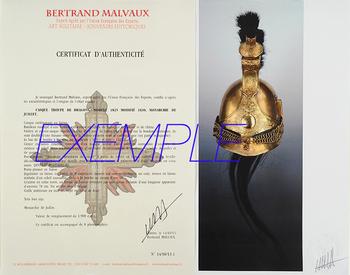
Next update Friday, april 4th at 1:30 PM
FOR ALL PURCHASES, PAYMENT IN MULTIPLE CHECKS POSSIBLE
bertrand.malvaux@wanadoo.fr 06 07 75 74 63
An authenticity certificate of the item including the description published on the site, the period, the sale price, accompanied by one or more color photographs is automatically provided for any item priced over 130 euros. Below this price, each certificate is charged 5 euros.
Only items sold by me are subject to an authenticity certificate, I do not provide any expert reports for items sold by third parties (colleagues or collectors).
